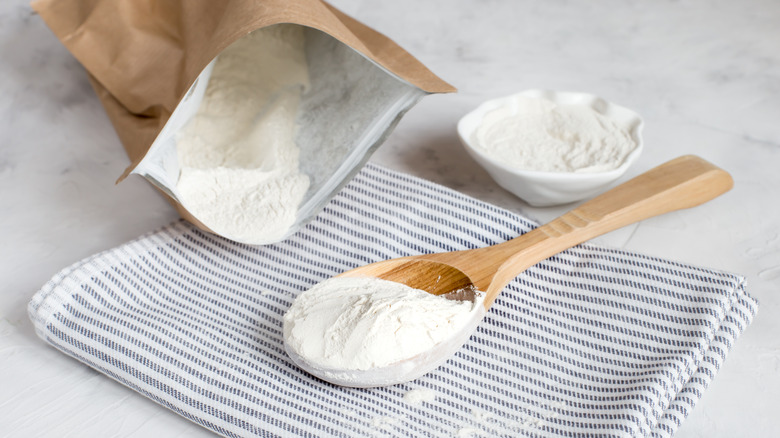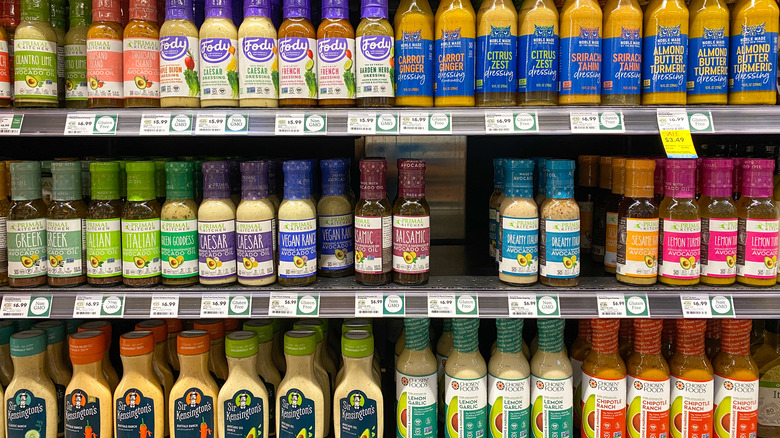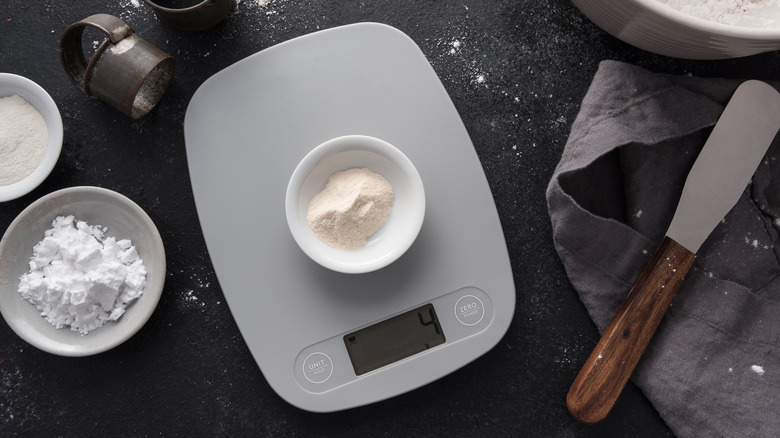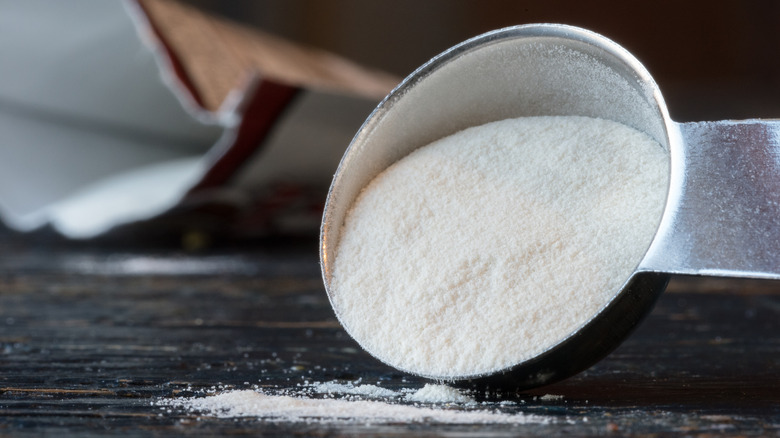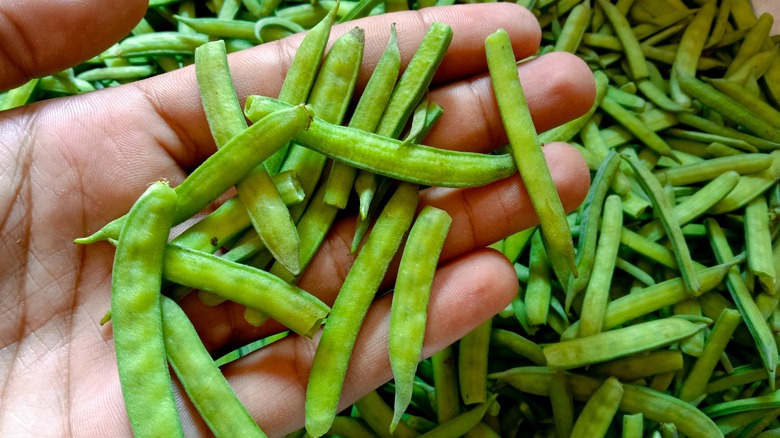What Is Xanthan Gum And Why Is It Added To Food?
Unless you're familiar with the world of gluten-free baking, xantham gum may not exactly roll off your tongue. While the odds are you have minimal, if not zero, idea of what it is, the odds are pretty high that you've consumed it before in some form or another.
Xantham gum is a very popular packaged food additive. From bottled salad dressings to ice cream to soups and syrups, you're probably eating it on a daily basis. Or perhaps you're applying it to your body, as it is also commonly found in toothpaste, cosmetics, lotions, and shampoo. And if you've somehow avoided those two methods of exposure, paints, adhesives, toilet bowl cleaners, and insecticides also carry the ubiquitous gum.
Why is it seemingly everywhere? Well, it aids with the texture, consistency, and appearance of a product and extends the shelf life – all profitable aspects from a manufacturer's perspective. But what exactly is it, what is it used for, and is it safe?
What is xantham gum?
Simply put, xantham gum is a polysaccharide. A polysaccharide is a kind of carbohydrate or a string of sugars. One of its main functions is acting as an emulsifier stabilizer. An emulsifier helps two ingredients that normally do not mix (think oil and vinegar) stick together. In the case of that oil and vinegar in a homemade salad dressing, a little dijon mustard helps them come — and stay — together nicely. Xanthan gum acts in a similar way with liquids in packaged foods by preventing that separation.
Perhaps its most impressive role is mimicking gluten in gluten-free baked goods. It helps create that doughy, stretchy, elastic texture that gluten is responsible for.
Xantham gum is made from a bacteria called Xanthomonas campestris. The bacteria is found on cruciferous vegetables such as brussel sprouts and cauliflower. It's made through a fermentation process where the bacteria is fed a sugar (either glucose or sucrose from corn, soy, or wheat). This creates a sticky substance (hence the "gum"), which is then made into a solid with the help of isopropyl alcohol. It is then dried and turned into a powder.
Xantham gum is synthetic – it is not found in nature in the form we consume in products, and our bodies are not able to digest it.
How to cook and bake with xantham gum
There are two main utilizations of xantham gum: as an emulsifier stabilizer and as a thickening agent. Its more popular use is probably as a thickening agent. Thickening sauces or soups with the powder is easy. Much like how you'd make a slurry with cornstarch, you can first add the xantham gum to some of the liquid to thicken and then mix it throughout the dish.
Xantham gum is unaffected by temperature and can be added to hot or cold foods. It has no taste, smell, or color, and a little goes a long way. A general guideline is ¼ teaspoon of xantham gum per every cup of liquid in the soup. If you're thickening a sauce, add a small amount of the powder at a time while whisking until you reach the desired consistency.
When using xantham gum as a gluten-free alternative in a baked good like a muffin, it's a straightforward ½ teaspoon per every cup of almond, tiger nut, or whichever gluten-free flour you are using. Be sure to check the ingredient list on any pre-made gluten-free flour blend, as they often already contain xantham gum. For doughs, breads, or other yeast-containing recipes, up the amount to one teaspoon per cup.
For those at-home ice cream makers, xantham gum also offers up a creamy texture by inhibiting the formation of ice crystals. It's perfect for non-dairy frozen desserts by allowing you to skip the heavy cream without sacrificing the mouthfeel.
Xantham gum nutrition
As a soluble fiber, our body is incapable of breaking down, xanthan gum offers us no nutrition or calories when consumed. Soluble fiber absorbs water in your digestive system, turning it into a gel-like substance. This slows down digestion and ultimately may help slow down the release of glucose into your bloodstream, mitigating a blood sugar spike. A study published in Food Science and Technology Research in 2016 found xantham gum may aid in lowering blood sugar. It has also been linked to lowering cholesterol when consumed in large amounts. Xantham gum may also aid in weight loss by increasing a sense of fullness and slowing digestion after consumption.
A study conducted on mice published in International Immunopharmacology in 2009 found that it can slow the growth of cancerous tumors. While all is promising, further research is needed.
Xantham is vegan and gluten-free, though it may be derived from common allergens such as corn, wheat, soy, or dairy.
How safe is xantham gum?
Xantham gum is recognized as safe by the Food and Drug Administration. Though because our bodies do not digest it, it can cause issues for those with any digestive or gastrointestinal disturbances going on. Consuming large amounts of it can lead to gas, bloating, or diarrhea, thanks to its laxative effects.
As long as it's consumed in moderate amounts, up to 15 grams per day, it should not cause any problems. The average person typically doesn't surpass 1 gram a day; however, the FDA places no limitation on the amount that can be added to products. Those with severe allergies — particularly corn, soy, or wheat from which it is commonly made — may want to check with their physicians and avoid it as well.
And while conducted only on animals, a study published in PLoS One in 2019 concluded consuming large amounts of xantham gum on a regular basis may increase inflammation. A comparative study conducted on humans published in the British Journal of Nutrition in 1993 found it may alter gut bacteria when consumed in large amounts, which could possibly be beneficial by promoting good bacteria growth.
Xantham gum vs. guar gum
In the world of additives in packaged foods, especially of the gluten-free variety, xantham gum and guar gum may be neck-and-neck in terms of popularity and frequency. Both act as thickeners and help keep your ingredients combined. They are often used together in gluten-free baking.
One main difference is that xantham gum is the better choice for baked goods and yeasted breads. Guar gum is better suited for cold foods such as ice cream. Citrus is enemy of guar gum's thickening abilities, so xantham is the way to go for anything calling for lemon juice or other acidic citrus components.
While xantham gum is made from a bacteria, guar gum hails from the seed of a legume plant, called guar beans, in Asia. It is also a polysaccharide, or chain of sugars. Those who are sensitive to corn or soy may choose to opt for guar gum over xantham gum, while those sensitive to legumes may want to do the opposite. When subbing in guar gum for xantham gum, slightly more is needed, so it is best to consult the packaging or manufacturer for conversion rates.
